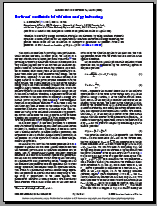
A new paper on energy harvesting has been published by L. Gammaitoni, I. Neri and H. Vocca on Applied Physics Letters (APL 94, 164102, 2009). This paper follows the previous letter on Nonlinear Energy Harvesting (see F. Cottone, H. Vocca, and L. Gammaitoni, Phys. Rev. Lett. 102, 080601) and generalizes the results obtained to a wider class of nonlinear oscillators.
Whati is the paper about?
The search for solutions in powering small portable electronic devices has been, in recent years, the subject of a relevant scientific and technological effort worldwide.
The powering of remotely distributed wireless micro sensors is a very challenging task due to the fact that the traditional approach based on batteries revealed impracticable for a number of reasons, chief among them the impossibility to replace them once they have exhausted their charge. On the other hand, especially in the case of mobile devices, it is highly desirable to have power sources co-located with the microdevices.
The current solution is to harvest the ambient energy where and when necessary, whether this be electromagnetic (light), thermal or mechanical in nature. Due to the almost ubiquitous presence of ambient kinetic energy, mostly in the form of random vibrations, a significant attention has been devoted to the conversion of mechanical energy into electric power exploiting piezoelectricity, e.m. induction or capacitance variations. In all these cases, the traditional approach is based on the resonant tuning of the mechanical oscillator. However, difficulties arise both because the tuning of the oscillators is constrained by geometrical factors and because the energy spectra of the available vibration is commonly spread in a wide frequency range, with the prevalence of low frequency components.
Recently, at NiPS lab it has been proposed to overcome such limitations by considering nonlinear oscillators instead of linear, i.e. resonant, ones. Specifically, it has been shown that a bistable oscillator (a biased inverted pendulum) can outperform a linear oscillator (simple inverted pendulum) in the presence of a wide spectrum vibration if some bias parameter is optimized.
In this new paper it is shown that these results represent a special case of a more general behavior and that the increased performances of nonlinear oscillators can be found, also in monostable/multistable nonlinear dynamics achievable in a number of different systems and geometries.
Download the new paper here
